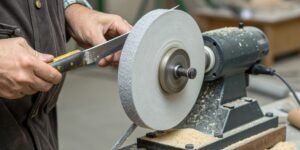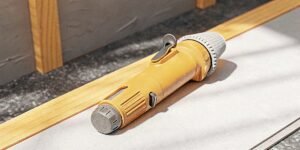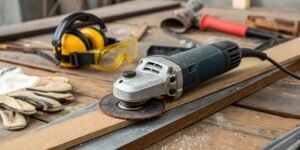
Is It Safe to Use an Angle Grinder with Wood Cutting Blades?
Are you tempted to use your angle grinder for a quick woodcutting job? It seems fast and easy, but this common shortcut can lead to disaster. Know the risks before you start.
No, it is not safe to use an angle grinder with most wood cutting blades. Angle grinders operate at extremely high RPMs, which can cause violent kickback when cutting wood. This makes them dangerously difficult to control and can lead to severe injuries.

Using the right tool for the job isn’t just about getting a clean cut; it’s about keeping yourself safe. I’ve been in the grinding tool business for almost three decades here in Henan, China, and I’ve heard too many horror stories. People see an angle grinder1 as a versatile powerhouse, which it is, but that power has limits and specific applications. When you try to make it do something it wasn’t designed for, like cutting wood, you’re not just bending the rules—you’re inviting a serious accident. Let’s break down exactly why this combination is so dangerous and what you should know to stay safe.
Can I Use My Angle Grinder to Cut Wood?
You have a powerful angle grinder and a piece of wood that needs cutting. It seems like a quick solution, but using the wrong tool can turn a simple task into an emergency.
Technically you can, but it is extremely dangerous and highly discouraged. The high speed of an angle grinder is meant for grinding metal or masonry, not cutting wood. The tool can easily catch in the wood, creating a violent kickback that you cannot control.

Why an Angle Grinder Fails with Wood
The core problem is a mismatch between the tool’s design and the material’s properties. An angle grinder’s immense rotational speed, often exceeding 10,000 RPM, is perfect for abrasive tasks on hard, uniform materials. Wood, however, is a different story. It’s fibrous, has grain, and can have hidden knots. When a high-speed blade hits these inconsistencies, it doesn’t just cut; it bites and grabs. This creates a massive rotational force that transfers back to the user, known as kickback2. Unlike a circular saw, which has a large base plate and two handles for stability, a handheld angle grinder offers very little leverage to resist this force. Your grip strength is simply no match for the torque of the motor. It can wrench the tool right out of your hands, sending it flying toward you or others nearby.
Can You Get Wood Blades for an Angle Grinder?
You’ve seen them online or maybe even in a local store: blades that claim to be for cutting wood with an angle grinder. This makes it seem like a valid option, doesn’t it?
Yes, manufacturers do produce "wood cutting" or "carving" discs for angle grinders. However, just because they exist does not mean they are safe for all users or all applications. These are specialty tools often intended for sculpture or rough shaping, not for straight cutting.

Understanding Specialty Discs
These blades are very different from a standard circular saw blade. They are often called carving discs or chain discs. Let’s look at the common types and their intended, very specific, uses.
| Disc Type | Intended Use | Risk Level |
|---|---|---|
| Chain Disc | Aggressive carving, shaping, sculpting by experienced professionals. | Very High |
| Carbide-Grit Disc | Shaping and sanding wood, removing material without deep cuts. | High |
| Multi-Purpose Blade | Marketed for cutting wood, plastic, and soft metals. High kickback risk. | Very High |
These tools are not for beginners. In our factory, we produce cutting tools designed for specific materials. We understand how force and material interact. These carving discs3 are designed to be used by experienced wood carvers who understand how to approach the wood grain and control the tool with incredible precision. They are not for making quick cuts or for general carpentry. Even for an expert, the risk is substantial. For a typical user, attaching one of these to an angle grinder for a simple cut is one of the most dangerous things you can do in a workshop.
Are Angle Grinder Wood Blades Safe?
The availability of these blades creates a false sense of security. If you can buy it, it must be safe to use, right? This is a dangerous assumption that can lead to life-altering injuries.
No, for general wood cutting, angle grinder wood blades are fundamentally unsafe. The design of the tool itself, combined with the nature of wood, creates a high-risk situation. Safety organizations and tool manufacturers universally warn against this practice for a reason.

The Physics of Danger
Let’s get into the details of why it’s so risky. It’s all about control. An angle grinder has no riving knife, which is a key safety feature on table saws and some circular saws that prevents the wood from pinching the blade from behind. It also lacks the large guard and stable base of a circular saw. When you use a toothed blade on an angle grinder, a few things can happen. First, the blade can bind in the cut if the wood moves or closes up. Second, if you hit a knot or change in grain density, the blade can grab violently. In either case, the result is kickback. This isn’t a small jolt; it’s an explosive reaction where the tool is thrown back at the operator at high speed. As a manufacturer of industrial tools, safety is our top priority. We wouldn’t sell a product combination that we knew was this hazardous. The potential for the blade to shatter or the tool to fly out of your control is just too high.
Can You Put a Cutting Blade on an Angle Grinder?
So, if wood cutting blades are out, what about other cutting blades? This opens up another important safety discussion about using the right disc for the right job.
Yes, you can and should put cutting blades on an angle grinder, but only the ones specifically designed for it. These are abrasive discs for cutting metal, tile, or masonry, not toothed blades.

Choosing the Right Disc
Your angle grinder is a cutting machine, but only with the proper accessories. As a company that produces a huge range of abrasive discs4, I know the science that goes into matching a disc to a material.
- For Metal: Use a thin abrasive "cut-off" wheel. These discs are made from materials like aluminum oxide and are designed to wear away as they cut through steel, iron, or other metals. They don’t have teeth that can snag.
- For Masonry: Use a diamond-tipped blade. These blades have a steel core with a rim of diamond segments. They grind through concrete, brick, or tile rather than cutting it with teeth, which makes them much safer and more controllable.
- For Grinding: Use a thicker grinding wheel. These are designed for removing material from a surface, not for cutting through it.
The key takeaway is that safe angle grinder "cutting blades5" are actually abrasive wheels. They grind their way through the material. Toothed blades that rip and tear, like wood blades, are not compatible with the high-speed, low-torque design of an angle grinder. Using the wrong disc is just as dangerous as using the tool on the wrong material. Always check the disc’s label for the recommended material and maximum RPM.
Conclusion
Never use an angle grinder for cutting wood. The tool’s high speed and lack of safety features create a severe risk of kickback and injury. Always use the right tool.
-
Understanding the risks associated with angle grinders can help you avoid serious injuries and choose the right tools for your projects. ↩
-
Learn about kickback and how it can lead to dangerous situations when using power tools, ensuring your safety. ↩
-
Learn about the specific uses of carving discs and why they are not suitable for general wood cutting. ↩
-
Understanding abrasive discs can help you select the right tools for cutting metal, tile, or masonry safely. ↩
-
Learn about the appropriate cutting blades for angle grinders to ensure safe and effective use. ↩
Written by
leeon
You may also be interested in:

How to use a hard felt bench grinding wheel on knives?
Getting a razor-sharp, polished edge on a knife can be frustrating and slow. A dull knife is dangerous, and using the wrong tool can easily

What does an angle grinder do that other tools can't?
Struggling with tools for multiple tasks? Carrying a heavy toolbox is inefficient. An angle grinder replaces many tools, saving you time and effort on the

Which material is used in making cutting wheel?
Have you ever used a cutting wheel that wore out too fast or just wouldn’t cut? The right material is key to solving this problem

What is the smallest angle grinder?
Finding a grinder for tight spaces is tough. The wrong tool damages your work. Let us guide you to the perfect compact angle grinder for

Can you cut a pipe with a grinder?
Struggling to cut a pipe quickly and cleanly? Using the wrong tool can be slow, messy, and dangerous. An angle grinder is a powerful option

When should you use an angle grinder?
Feeling unsure about which tool to grab? Using the wrong one can waste materials and time. An angle grinder is a powerful, versatile solution for
